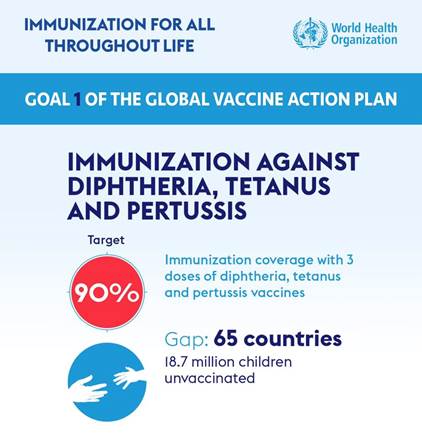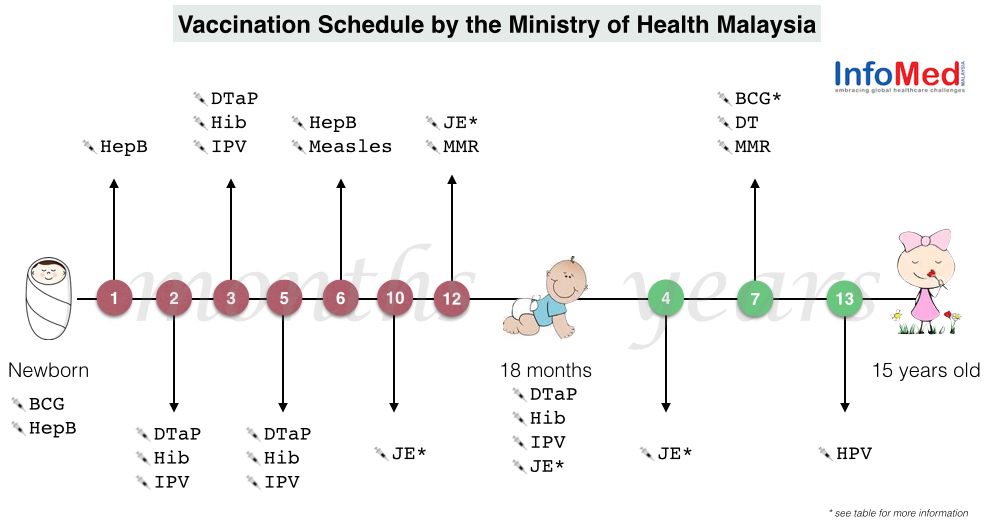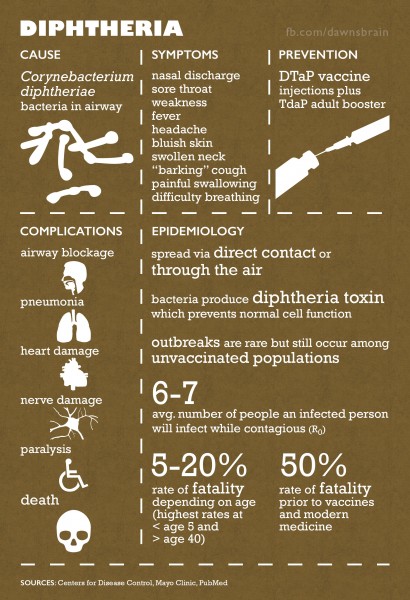Is it not incomprehensible that, since 2004, the United States has had only two documented cases of diphtheria infection, whilst in Malaysia we’ve had 15 confirmed cases in the last six months with at least five (5) fatalities? Seven cases with one death were reported in Kedah; three with one death in Melaka; four with three deaths in Sabah and one case in Negri Sembilan. Under the National Economic Transformation Programme (ETP), the Malaysian government has assigned Healthcare as one of the National Key Economic Areas; an area of high priority in development and funding. As ETP has pledged to a more accessible and higher quality healthcare, Malaysians should display outrage towards these numbers, especially when three of these fatalities were young children. As responsible citizens, it is time to face diphtheria and all other threats to the health of our children head on.
In Malaysia, the vaccine for diphtheria infection is not compulsory, meaning that parents can choose for their children to skip the vaccine with no legal consequences. This is in contrast to our neighbour Singapore, where the vaccine is mandatory and every child must be vaccinated, without exception. Because the vaccine is administered long before the individual becomes a legal adult, whether or not a child receives a vaccine lies in the hands of the parents.
The anti-vaccine movement first gained traction in the state of Kedah, and today the vaccine wary mind set has spread nationwide. Malaysian campaigns against vaccines pull forth several different arguments, many of which have no scientific support. Tragically, in the month of June, three young children from Sabah, Kedah and Malacca died due to complications of diphtheria infection. Had each child received the vaccine, perhaps the tragedies could have been avoided. In light of these premature deaths, it is of utmost importance that we debunk the myths surrounding diphtheria infection and review the available methods to stay safe.  Dr Verna Lee Kar Mun, of IMU Healthcare Medical Clinic, offers a perspective on the matter of vaccines. She says that, “In regards to these vaccinations, everyone is entitled to their own opinion,” but as a doctor she suggests looking at the odds. The United States has seen a 100% decrease in Diphtheria bacterial infections since the pre-vaccine era (Centre for Disease Control, USA). The Centre for Disease Control states that the DTAP vaccine contains aluminium phosphate, formaldehyde, glutaraldehyde and 2-Phenoxyethanol. Each of these chemicals is used to either increase the speed and effectiveness of the vaccine, act as a preservative, or inactivate the bacteria or virus so that the vaccinated individual does not contract the disease. The World Health Organization (WHO) has a simple stance on vaccines. In their own words, they acknowledge immunisation via vaccines as a “proven tool for controlling and eliminating life-threatening infectious diseases”. The WHO stresses that vaccines are also extremely cost effective, and that receiving vaccines does not result in any significant lifestyle change or negative health outcome. The WHO has also launched a new initiative paired with the slogan “Close the Immunization Gap”. Their aim is to make vaccines more affordable and accessible to less privileged and more remote communities.
Dr Verna Lee Kar Mun, of IMU Healthcare Medical Clinic, offers a perspective on the matter of vaccines. She says that, “In regards to these vaccinations, everyone is entitled to their own opinion,” but as a doctor she suggests looking at the odds. The United States has seen a 100% decrease in Diphtheria bacterial infections since the pre-vaccine era (Centre for Disease Control, USA). The Centre for Disease Control states that the DTAP vaccine contains aluminium phosphate, formaldehyde, glutaraldehyde and 2-Phenoxyethanol. Each of these chemicals is used to either increase the speed and effectiveness of the vaccine, act as a preservative, or inactivate the bacteria or virus so that the vaccinated individual does not contract the disease. The World Health Organization (WHO) has a simple stance on vaccines. In their own words, they acknowledge immunisation via vaccines as a “proven tool for controlling and eliminating life-threatening infectious diseases”. The WHO stresses that vaccines are also extremely cost effective, and that receiving vaccines does not result in any significant lifestyle change or negative health outcome. The WHO has also launched a new initiative paired with the slogan “Close the Immunization Gap”. Their aim is to make vaccines more affordable and accessible to less privileged and more remote communities.
So, what is diphtheria? The WHO recognises diphtheria as a condition triggered by the bacterium Corynebacterium diphtheria. This bacteria releases a toxin that can cause severe damage to human body tissue and organs. In the past, diphtheria was a common cause of death.
Hippocrates observed diphtheria as early as 500 B.C., but it was not until 1882 that Edwin Klebs correctly identified the organism responsible for the disease. In the 20th century, real progress was achieved in combatting diphtheria, in the form of immunisation through vaccines. The Ministry of Health Malaysia provides a vaccination schedule of the various vaccines that should be assigned throughout a child’s life. “Government issued vaccinations are free and easy to access,” clarifies Dr Verna, “They provide the biggest platform for immunisation.” The schedule includes the Hepatitis B and BCG vaccines given to infants and the HPV vaccines given to teen girls. 
The vaccine for diphtheria, tetanus and acellular pertussis, abbreviated as DTaP, is usually administered from the age of 2 months onwards in three primary doses. Typically, children receive the 2nd dose at 3 months, the 3rd dose at 5 months and the first booster dose at 18 months. After these dosages, children can receive the second and third boosters at the age of 7 and 15 years old respectively from the school health teams.
It’s easy to think that in order to avoid diphtheria, one simply has to avoid contact with the infected person, and that vaccinations are unnecessary. Do not be deceived. Bacteria do not only dwell in disgusting sewers or trash heaps. Just washing your hands or wearing a surgical mask simply won’t suffice. In Dr Verna’s opinion, the latter method has very little to do with protection against bacteria. “A thin sheet of material still cannot prevent you from getting sick or even prevent others from catching your ailment. It does however serve as a symbol of sorts, so that the people around you will know that you are sick and can keep their distance.” The point is that bacteria is everywhere, and Malaysia, being a warm and humid country, provides a perfect breeding ground for all sorts of life, including bacteria.  Because bacteria is everywhere, playing a game of chance is especially dangerous when it comes to diphtheria, which is potentially fatal and highly contagious. Diphtheria is usually contracted due to direct exposure via air droplets,” explains Dr Verna, “Or from someone who has been infected with diphtheria.” It mostly affects the nose and throat region, and symptoms include a high temperature (38°C and above), trouble breathing, grey-thick substance at the back of the throat as well as soreness of the throat. Estimates from the UK National Health Service say that up to 10% of those with diphtheria could die due to complication of the illness. “Those with weaker immune systems and children are especially at risk,” says Dr Verna. Once confirmed clinically, the treatment for diphtheria consists of a course of antibiotics medicine. So if you see these symptoms manifest in yourself or a loved one, take precaution and visit your family doctor immediately. When victims begin to suffer from further complications concerning the heart or nervous system, they may be referred and admitted to the intensive care ward.
Because bacteria is everywhere, playing a game of chance is especially dangerous when it comes to diphtheria, which is potentially fatal and highly contagious. Diphtheria is usually contracted due to direct exposure via air droplets,” explains Dr Verna, “Or from someone who has been infected with diphtheria.” It mostly affects the nose and throat region, and symptoms include a high temperature (38°C and above), trouble breathing, grey-thick substance at the back of the throat as well as soreness of the throat. Estimates from the UK National Health Service say that up to 10% of those with diphtheria could die due to complication of the illness. “Those with weaker immune systems and children are especially at risk,” says Dr Verna. Once confirmed clinically, the treatment for diphtheria consists of a course of antibiotics medicine. So if you see these symptoms manifest in yourself or a loved one, take precaution and visit your family doctor immediately. When victims begin to suffer from further complications concerning the heart or nervous system, they may be referred and admitted to the intensive care ward.
It does seem unfortunate that children have to lose their lives to a disease that can be prevented or at least mitigated through use of a vaccine. Of course, children cannot make these decisions for themselves, and it is the responsibility of every parent to weigh the options and decide the best for their child.
The vaccine debate has been around ever since vaccines came into use for the masses, and it is a debate that will continue in the years to come. Regardless of this, Malaysians need to actively contemplate the threat of infections and refer to scientific evidence when it comes to their children’s healthcare. The ‘it won’t happen to me’ mind set has been proven to fail time and time again. Developed countries have all but eradicated reports of diphtheria due to stringent enforcement of vaccines. At this point in time, Malaysia should be making strides in healthcare instead of regressing behind. Understanding the various threats to our well-being is the first step towards becoming more aware and healthier as a nation. It is never too late to get your missed childhood vaccines today. Sources: http://www.straitstimes.com/asia/outrage-over-diphtheria-deaths-in-malaysia http://www.themalaymailonline.com/malaysia/article/no-diphtheria-case-in-putrajaya-health-d-g-says http://english.astroawani.com/malaysia-news/no-diphtheria-putrajaya-says-health-dg-112352 http://www.who.int/topics/immunization/en/ http://www.who.int/immunization/topics/diphtheria/en/ https://en.wikipedia.org/wiki/Diphtheria http://vaccines.procon.org/view.resource.php?resourceID=005206#aluminum https://www.cdc.gov/vaccines/pubs/pinkbook/downloads/appendices/b/excipient-table-2.pdf http://www.ncbi.nlm.nih.gov/books/NBK7971/ http://www.nhs.uk/conditions/diphtheria/pages/introduction.aspx This article is brought to you by IMU Healthcare.









